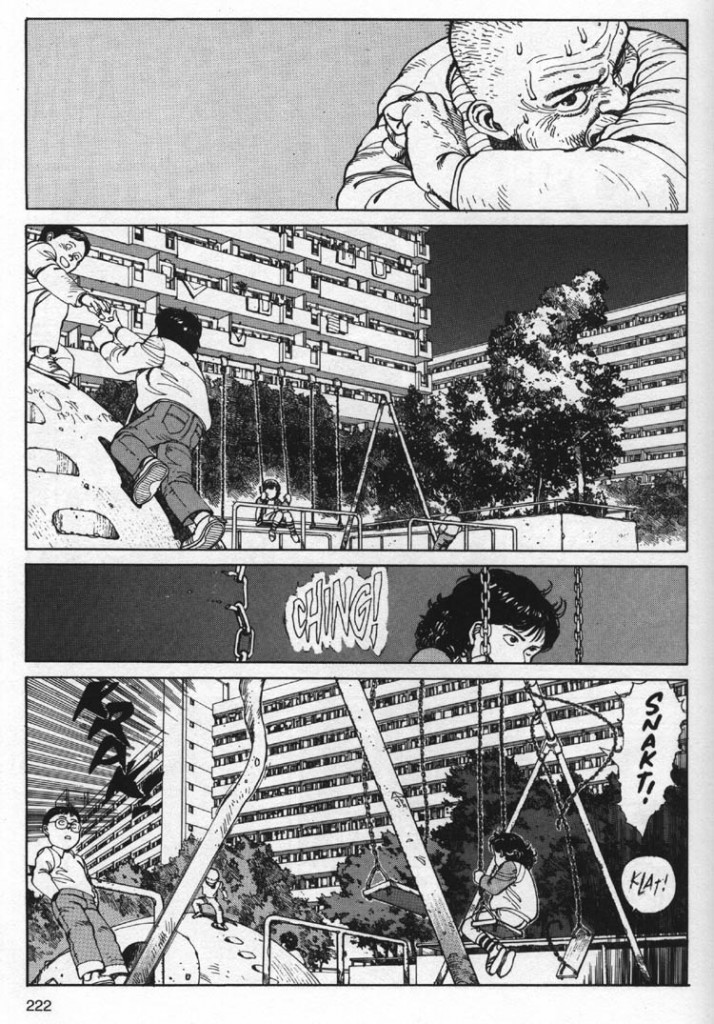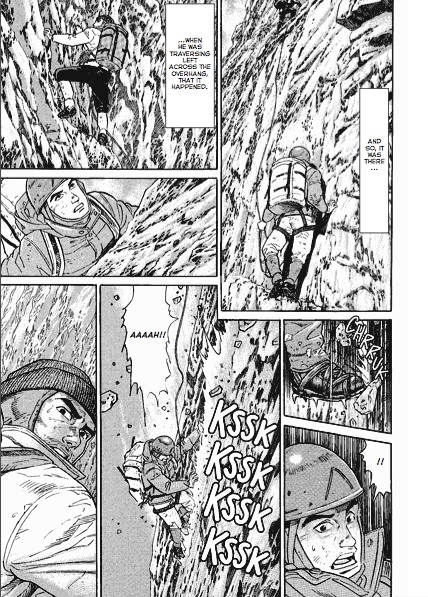 Revisiting AKIRA prompted me to re-read Domu: A Child’s Dream, an earlier work that helped cement Katsuhiro Otomo’s reputation as the leading manga-ka of his generation. Though both series include elements of horror and science fiction, the two are utterly different in approach: AKIRA is sweeping, grand, and allegorical, whereas Domu is compact, a taut psychological thriller that unfolds in a mere 230 pages.
Revisiting AKIRA prompted me to re-read Domu: A Child’s Dream, an earlier work that helped cement Katsuhiro Otomo’s reputation as the leading manga-ka of his generation. Though both series include elements of horror and science fiction, the two are utterly different in approach: AKIRA is sweeping, grand, and allegorical, whereas Domu is compact, a taut psychological thriller that unfolds in a mere 230 pages.
Domu begins like a police procedural: an older detective and his hot-headed young partner arrive at a Tokyo apartment complex to investigate a series of deaths. Though the victims’ histories suggest foul play rather than suicide, the detectives are baffled by the crime scenes: all of the victims have jumped off rooftops or slashed their own throats, with no evidence of anyone watching or aiding them. A few tantalizing clues lead investigators to “Old Cho,” a seemingly benign, senile resident who spends most of his time sitting on a bench and muttering. Inspectors Yamagawa and Tamura can’t connect Cho to the crimes, but Etsuko, a stolid little girl who has just moved into the complex, knows how Cho killed them: telekinesis and hypnotic suggestion.
What follows is an intensely creepy cat-and-mouse game between Etsuko and Cho. Though Cho is nominally an adult, his mind is terrifyingly child-like; he kills his neighbors for their “treasures”: a baseball cap with wings, a fake ruby ring, an umbrella, a stuffed toy. Cho initially regards Etsuko as an impediment to his fun, but when he discovers that Etsuko can also move objects with her mind, he begins testing her strength and sense of morality. Their battle begins in the narrow hallways and dim elevator shafts of Etsuko’s building, but quickly consumes the entire complex as Cho attempts to annihilate Etsuko.

Though I found the artwork for AKIRA a bit dated, a relic of a particular moment in sci-fi history, Domu seemed less mired in the 1980s. The characters are refreshingly realistic in their appearance; Cho actually looks like an eighty-year-old man, with a stooped frame, a deeply-etched face, and liver-spotted hands, while Etsuko’s plump cheeks and slightly awkward proportions seem appropriate for an eight-year-old. Otomo lavishes similar attention on his bit players, too, giving each apartment dweller a distinctive look that speaks volumes about his economic status, age, and fear of being swept up in Yamagawa and Tamura’s murder investigation. Even the apartment complex functions as a kind of character, a sterile collection of high-rise buildings whose imposing exteriors give way to dark, dingy interiors and cramped apartments. As Otomo guides us through its labyrinthine hallways and stairwells, we feel a palpable sense of dread; the complex is filled with the kind of dead ends and blind spots that feature prominently in our worst nightmares.
Domu would be a solid, if not remarkable, thriller on the strength of its artwork alone, but Etsuko’s predicament gives the story an added jolt of energy and terror. She’s the strongest, most adult character in the story, the only one with a clear sense of what’s happening, and the only one powerful enough to stop Cho. Making her plight more compelling is the fact that Etsuko behaves like an eight-year-old who just happens to have a deadly gift, rather than a god-like creature who just happens to be eight years old; she’s small and vulnerable, eager for the comfort of her mother’s arms, but she’s also fiercely moral and incredibly brave in the face of nightmarish events, a child whose natural desire to set things right is cruelly tested by a childish adult.
N.B. Domu has been out of print for several years, though copies are relatively easy to find through eBay and Amazon’s extended seller network. Dark Horse released Domu in several formats, including three slim TPBs and an omnibus edition.

 My first exposure to Katsuhiro Otomo came in 1990, when a boyfriend insisted that we attend a screening of AKIRA at an artsy theater in the Village. I wish I could say that it had been a transforming experience, one that had awakened me to the possibilities of animation in general and Japanese visual storytelling in particular, but, in fact, I found the film tedious, gory, and self-important. Little did I imagine that I’d be reviewing AKIRA nineteen years later, let alone in its original graphic novel format.
My first exposure to Katsuhiro Otomo came in 1990, when a boyfriend insisted that we attend a screening of AKIRA at an artsy theater in the Village. I wish I could say that it had been a transforming experience, one that had awakened me to the possibilities of animation in general and Japanese visual storytelling in particular, but, in fact, I found the film tedious, gory, and self-important. Little did I imagine that I’d be reviewing AKIRA nineteen years later, let alone in its original graphic novel format. I read a Rumiko Takahashi manga for the same reason I watch an Alfred Hitchcock thriller: I know exactly what I’m going to get. Certain plot elements and motifs recur throughout each artist’s work — Hitchcock loves pairing a brittle blond with a rakish cad on the run from authorities, for example, while Takahashi loves pairing a female “seer” with a demonically-tinged boy — yet the craft with which Hitchcock and Takahashi develop such tropes prevents either artist’s work from feeling stale or repetitive. Takahashi’s latest series gives ample proof that while she may have a limited repertory, she’s the undisputed master of the supernatural mystery.
I read a Rumiko Takahashi manga for the same reason I watch an Alfred Hitchcock thriller: I know exactly what I’m going to get. Certain plot elements and motifs recur throughout each artist’s work — Hitchcock loves pairing a brittle blond with a rakish cad on the run from authorities, for example, while Takahashi loves pairing a female “seer” with a demonically-tinged boy — yet the craft with which Hitchcock and Takahashi develop such tropes prevents either artist’s work from feeling stale or repetitive. Takahashi’s latest series gives ample proof that while she may have a limited repertory, she’s the undisputed master of the supernatural mystery.



 Warning: the Surgeon General has determined that reading Moyasimon: Tales of Agriculture may be hazardous to your health. Individuals who routinely consume large quantities of yogurt, miso, or natto; keep stashes of Purell in their purses and desk drawers; or have an irrational fear of germs or dirt are cautioned against reading Moyasimon. Side effects include disgust, nausea, and a strong desire to wash one’s hands repeatedly. Those with stronger constitutions, however, may find this odd little comedy fun, if a little too dependent on gross-out humor for laughs.
Warning: the Surgeon General has determined that reading Moyasimon: Tales of Agriculture may be hazardous to your health. Individuals who routinely consume large quantities of yogurt, miso, or natto; keep stashes of Purell in their purses and desk drawers; or have an irrational fear of germs or dirt are cautioned against reading Moyasimon. Side effects include disgust, nausea, and a strong desire to wash one’s hands repeatedly. Those with stronger constitutions, however, may find this odd little comedy fun, if a little too dependent on gross-out humor for laughs. The humor is good-natured, though Masayuki Ishikawa indulges his inner ten-year-old’s penchant for gross-out jokes every chance he gets.He repeatedly subjects Tadayasu and Kei to Itsuki’s food fetishes, forcing them to watch Itsuki exhume and eat kiviak (a fermented seal whose belly has been stuffed with birds), or try a piece of hongohoe, a form of stingray sashimi so pungent it makes their eyes water. Ishikawa’s decision to render the bacteria as cute, roly-poly creatures with cheerful faces prevents the story from shading into horror, though it’s awfully hard to shake the image of bacteria frolicking in a bed of natto or around the slovenly Misato’s nostril.
The humor is good-natured, though Masayuki Ishikawa indulges his inner ten-year-old’s penchant for gross-out jokes every chance he gets.He repeatedly subjects Tadayasu and Kei to Itsuki’s food fetishes, forcing them to watch Itsuki exhume and eat kiviak (a fermented seal whose belly has been stuffed with birds), or try a piece of hongohoe, a form of stingray sashimi so pungent it makes their eyes water. Ishikawa’s decision to render the bacteria as cute, roly-poly creatures with cheerful faces prevents the story from shading into horror, though it’s awfully hard to shake the image of bacteria frolicking in a bed of natto or around the slovenly Misato’s nostril. 9. NIGHTMARES FOR SALE
9. NIGHTMARES FOR SALE
 7. THE DEVIL WITHIN
7. THE DEVIL WITHIN 6. DRAGON SISTER!
6. DRAGON SISTER! 5. THE GORGEOUS LIFE OF STRAWBERRY-CHAN
5. THE GORGEOUS LIFE OF STRAWBERRY-CHAN 4. J-POP IDOL
4. J-POP IDOL 3. SERAPHIC FEATHER
3. SERAPHIC FEATHER 2. INNOCENT W
2. INNOCENT W 1. COLOR OF RAGE
1. COLOR OF RAGE 10. Miyuki-chan in Wonderland
10. Miyuki-chan in Wonderland 9. Nightmares for Sale
9. Nightmares for Sale 8. Arm of Kannon
8. Arm of Kannon 7. The Devil Within
7. The Devil Within 6. Dragon Sister!
6. Dragon Sister! 5. The Gorgeous Life of Strawberry-chan
5. The Gorgeous Life of Strawberry-chan 4. J-Pop Idol
4. J-Pop Idol 3. Seraphic Feather
3. Seraphic Feather 2. Innocent W
2. Innocent W 1. Color of Rage
1. Color of Rage After reading Missin’ and Missin’ 2, I’m convinced that novelist Novala Takemoto was a teenage girl in a previous life. But not the kind of girl who was on the cheerleading squad, the volleyball team, or the school council — no, Takemoto was the too-cool-for-school girl, the one whose unique fashion sense, sullen demeanor, and indifference to high school mores made her seem more adult than her peers, even if her behavior and emotions were, in fact, just as juvenile as everyone else’s. Though this kind of angry female rebel is a stock character in young adult novels, Takemoto has a special gift for making them sound like real girls, not an adult’s idea of what a disaffected teenager sounds like.
After reading Missin’ and Missin’ 2, I’m convinced that novelist Novala Takemoto was a teenage girl in a previous life. But not the kind of girl who was on the cheerleading squad, the volleyball team, or the school council — no, Takemoto was the too-cool-for-school girl, the one whose unique fashion sense, sullen demeanor, and indifference to high school mores made her seem more adult than her peers, even if her behavior and emotions were, in fact, just as juvenile as everyone else’s. Though this kind of angry female rebel is a stock character in young adult novels, Takemoto has a special gift for making them sound like real girls, not an adult’s idea of what a disaffected teenager sounds like. Built in 1607, the Ooku, or “great interior,” housed the women of the Tokugawa clan, from the shogun’s mother to his wife and concubines. Strict rules prevented residents from fraternizing with outsiders, or leaving the grounds of Edo Castle without permission. Within the Ooku, an elaborate hierarchy governed day-to-day life; at the very top were the joro otoshiyori, or senior elders, who supervised the shogun’s attendants and served as court liaisons; beneath them were a web of concubines, priests, pages, cooks, and char women who hailed from politically connected families. This elaborate social system was mirrored in the physical structure of the Ooku, which was divided into three distinct areas — the Rear Quarters, the Middle Interior, and the Front Quarters — each intended solely ladies of a particular rank. The only male permitted into the Ooku (unescorted, that is), was the shogun himself, who accessed the “great interior” by means of the Osuzu Roka, a long corridor that connected the shogun’s living quarters with the imperial harem.
Built in 1607, the Ooku, or “great interior,” housed the women of the Tokugawa clan, from the shogun’s mother to his wife and concubines. Strict rules prevented residents from fraternizing with outsiders, or leaving the grounds of Edo Castle without permission. Within the Ooku, an elaborate hierarchy governed day-to-day life; at the very top were the joro otoshiyori, or senior elders, who supervised the shogun’s attendants and served as court liaisons; beneath them were a web of concubines, priests, pages, cooks, and char women who hailed from politically connected families. This elaborate social system was mirrored in the physical structure of the Ooku, which was divided into three distinct areas — the Rear Quarters, the Middle Interior, and the Front Quarters — each intended solely ladies of a particular rank. The only male permitted into the Ooku (unescorted, that is), was the shogun himself, who accessed the “great interior” by means of the Osuzu Roka, a long corridor that connected the shogun’s living quarters with the imperial harem.